It is important to ensure that we meet users needs, this is what user-centered design is all about.
The problem with traditional development is that:
- Software engineering methodologies primarily focus on large, batch processing, non-interactive software systems (functionality and automation).
- It ignores the role of interactivity and the important of the user. Users are just an input and the end point the output.
Evolution of Software Development Methodologies
Waterfall Model (1970)
- Popular methodology.
- Sequential and discreet steps, can’t go back.
- Requirements are written up front.
Issues:
- Requirements usually from clients and not users.
- Requirements represented in speech/text.
- Contract comes before understanding user needs.
Boehm’s Spiral Model (1988)
- Major improvement.
- Spiral vs sequential steps.
- Some flexibility to go back.
- Each loop is a phase of the software process.
- Each phase begins with a design goal and ends with client reviewing progress.
- Incorporates risk management.
- No user involvement.
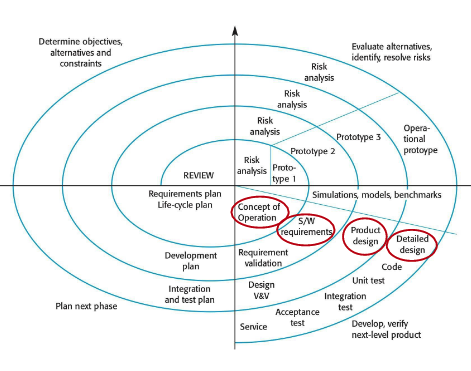
Agile Approach (2001)
- Much more flexible.
- Close collaboration with development team and business stakeholders.
Agile has four core values:
- Individuals and interactions over processes and tools.
- Working software over comprehensive documentation.
- Customer collaboration over contract negotiation.
- Responding to change over following a plan.
Why bother with Usability Engineering?
Usability engineering is a discipline that focuses on improving the usability and user friendliness of the interactive systems.
Pay a little now, or a pay a lot later.
63% of large software projects go over cost, managers gave four usability-related reasons:
- Users requested changes.
- Overlooked tasks by users/designers (both).
- Users did not understand their own requirements.
- Insufficient user-developer communication and understanding.
It is far too easy to jump into detailed design that:
- Is founded on incorrect requirements.
- Has inappropriate dialogue flow.
- Is not easily used.
- Is never tested until it is too late.
How can we engineer systems that consider the users? We need to work with potential users in an integrated design process.
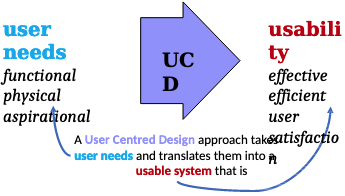
User-Centered Design (UCD)
UCD approaches:
- Requirements are clearly understood and articulated.
- Requirements are communicated to designers.
- Stakeholders are on board and involved.
- Evaluation takes place with actual users.
- User feedback is incorporated into the design.
- Preparation for handover to client is considered.
User-centered design is a ‘philosophy’ based on needs and interests of the user, emphasising on making the product usable and understandable.
- Places user at the centre of the design.
- Involves the user.
- Integrates knowledge/expertise from different disciplines in HCI.
- Highly iterative.

User-Centred Design Methods and Techniques
Soft Systems Methodology (SSM) 1990’s
It is a systems methodology: looks a the whole system (holistic not reductionist).
Emphasis on understanding the situation and solving complex problems:
- Used in early stages of design lifecycle.
- Used in systems analysis - which recognises the more complex and fuzzy nature of organisational life where a variety of goals are being pursued.
- Interpretive and subjective approach (opinions sought), not quantitative.
- User centred: values, beliefs and views.
It only takes analyst up to design, says nothing about implementation or evaluation.
The Seven Stages of SSM
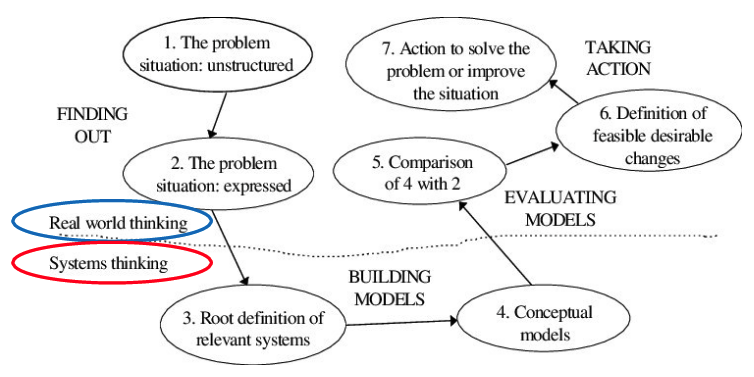
Usability Engineering Lifecycle (1999)
It was designed as a usability test plan and integrated into software development.
Iterative model including three phases:
- Requirement analysis - understand user issues, what tasks users need to do, set goals for usability study.
- Design, testing and development - conceptual design, project standards, final design.
- Installation - feedback from users.
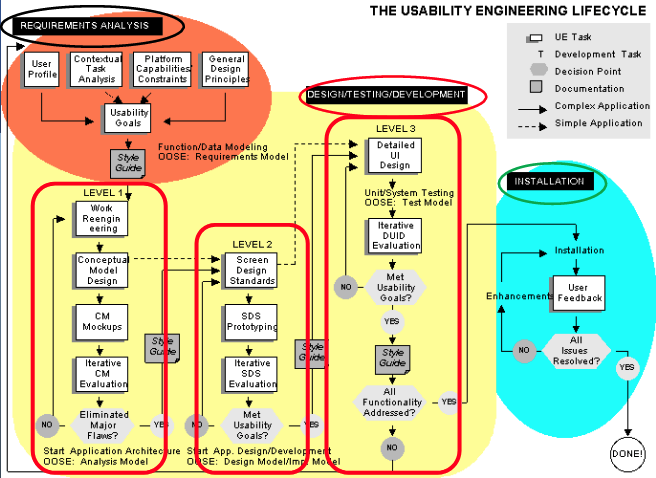
Star Lifecycle (1989)
It was developed by HCI professional and emphasises that ordering of activities is inappropriate.
It is evaluation centred and encourages iteration. It is also applicable to both small and large projects.
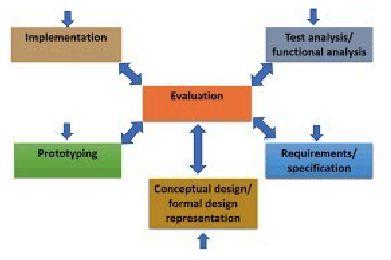
Pros and Cons
- Pros:
- It allows designers to match the process to their developing needs, because needs are hard to specify initially (as evaluation directs progress).
- Cons:
- Difficult to control process.
- Procedural models (e.g. waterfall) allow developers and managers to get an overall view of the development effort to track progress, specify deliverables, allocate resources and set targets.
Participatory Design (PD)
It brings users to the heart of the design process, they are involved with every stage of the design.
It came about due to other methods involving users at certain stages of the process only e.g. requirements gathering, evaluation etc.
Other terms: co-creation, co-design, co-operative design.
Users are the experts - they have knowledge that the designers/developers do not. They also take an active role in co-designing solutions for themselves.
Designing for them vs designing with them.
PD Methods
Anything goes but often workshop-based.
The aim is to encourage creativity and ‘out of the box’ thinking.
There are no fixed approach, methods or tools. It is about using the right combination for the job at hand.
Examples:
- Brainstorming - Love Letter/Breakup Letter, magic button.
- Practical - Lego, plasticine, wooden bricks, straws, rope.
- Understanding process/interaction - journey mapping, storyboards, role play.
- Technical - sketching, wireframes (low/hi fidelity), prototyping.
Pros and Cons
- Pros:
- Users’ sense of ownership is increased over end product.
- More likely to result in system that meets user needs, are usable, feasible and meaningful in their context.
- Cons:
- Can be complex and time consuming.
- Not really practical - getting all stakeholders together.
- Difficult to accommodate differing needs, desires and requirements from the stakeholders.
- Users’ and developers thinking is constrained by what they already know.
- Need to manage user expectations - not everything will be included in final design.
Human Centred Design Process - IDEO
It is a HCD discipline which starts with people and ends with innovative solutions to match user needs.
It has three phases:
- Inspiration - understand situation and people.
- Ideation:
- Make sense of what you’ve learned.
- Come up with lots of ideas.
- Design, prototype and evaluate, refine and iterate.
- Implementation - final solution.
Design Thinking Process
Discipline of design thinking, which originates from design.
Phases:
- Empathise - understand context and users.
- Define - define problem area.
- Prototype - build, evaluate and refine design.
- Test - test design with users and refine.
It is an iterative approach.
Double Diamond (The British Design 2005)
Discipline of design thinking, also originates from design.
Structured design approach to tackle challenges and problems.
It has four phases:
- Discover: insight into problem.
- Define: area to focus on.
- Develop: potential solutions.
- Deliver: solutions.
It is based on the concept of divergent and convergent thinking.
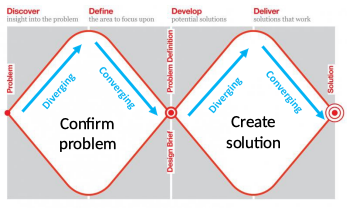
Double Diamond (adapted by Dan Nessler)
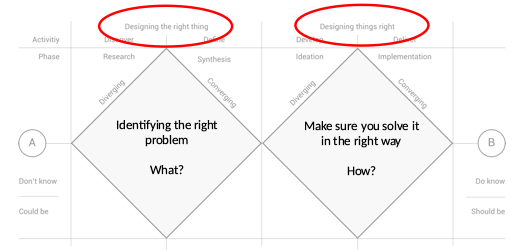
Stage 1 - Doing the Right Thing
It has research added to the Discover phase (diverging) and synthesis added to the Define phase (converging).
Discover/Research - understanding problem to be addressed:
- Think ‘outside of the box’ - rip the design brief.
- Cluster topics - organise findings, identify areas for focus.
- Research problems - primary and secondary.
Define/Synthesis - make sense of findings:
- Insights gained? What have you learnt?
- What themes have evolved?
- Create HMW (how might we) questions.
Stage 2 - Doing Things Right
- Ideation added to Develop phase (diverging).
- Implementation added to Deliver phase (converging).
Develop/Ideation - ideas to address problem:
- Ideate - come up with lots of ideas (out of the box thinking).
- Evaluate - evaluate ideas and select best/favourite ones.
Deliver/Implementation - develop final solution:
- Prototype, test and iterate selected ideas.
- Repeat.
- Converge on final solution - out.
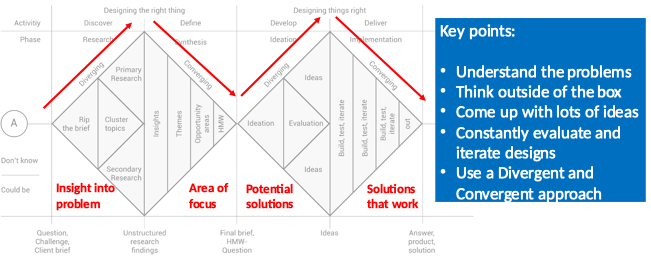
Lean UX (User Experience)
The aim is to create well designed products.
- Highly collaborative.
- Involves constant iteration.
- Frequent contact with users.
- Objective - to get feedback as quickly as possible.
- Focus - user needs and experience.
- Highly iterative.
- Compliments Agile development.
Phases:
- Outcomes - What are your assumptions about the user? Turn assumptions into hypothesis.
- Design - design product collaboratively.
- MVP - create basic mock-up to use with target users e.g. wireframes, prototype.
- Research and Learning - get user feedback on MVP.